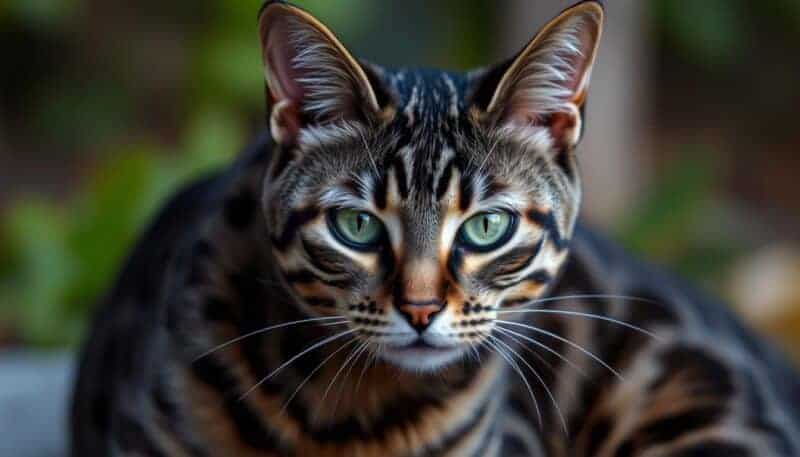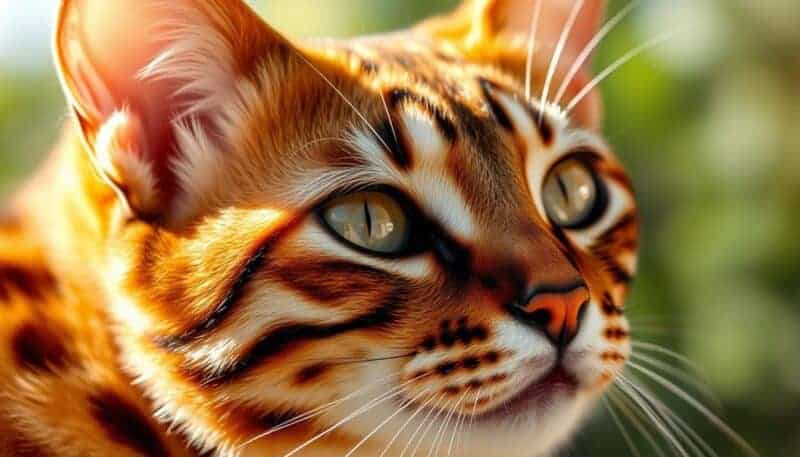Introduction
Understanding Bengal Cat Color Genetics
Basic Color Inheritance in Bengal Cats
The Role of Melanin in Bengal Coloration
Genetic Factors Affecting Pattern Development
“The mesmerizing colors and patterns of Bengal cats are the result of a captivating genetic symphony, orchestrated by the dance of pigments and the intricate choreography of their genetic blueprint.”
Bengal Cat Colors and Their Base Patterns
Spotted Bengal Cats
Rosetted Bengal Cats
Marbled Bengal Patterns
Spotted vs Rosetted Bengal Patterns
Characteristics of Single Spots
Complex Rosette Variations
How to Identify Different Spot Types
“The Bengal cat’s distinct patterns are a true testament to the breed’s genetic diversity and the captivating beauty of nature’s artistry.”
Marbled Bengal Patterns and Variations
“The marbled pattern in bengal cats is a true work of art, a captivating display of nature’s creative genius.”
The Distinctive Snow Bengal Colors
Explore the magical world of Snow Bengal colors. Here, cooler tones and captivating patterns take center stage. These Bengal cats stand out with their unique features, unlike their warmer-hued friends.
Seal Lynx Point Features
The Seal Lynx Point Bengal has a striking contrast. Its pale body meets deeper seal points on the face, ears, legs, and tail. This creates a sophisticated, almost regal look that many Bengal fans love.
Seal Sepia Snow Characteristics
Seal Sepia Snow Bengals have a soft, muted palette. Their body is subtly shaded, with deeper seal points. This creates a harmonious, understated elegance that catches the eye. These Bengals have a gentle, ethereal beauty.
Seal Mink Pattern Details
Seal Mink Bengals have a captivating blend of shades. They have a warm, beige-toned base with distinctive seal markings. This creates a stunning, natural-looking pattern that shows the wild’s grace and power. These Bengals are loved for their versatile and visually striking look.
“The Snow Bengal colors are a true testament to the breed’s versatility and the endless possibilities of feline genetics.”
Charcoal Bengal: A Unique Color Variation
The Charcoal Bengal is a standout among Bengal cat colors. It has captured the hearts of many, showing the amazing world of Bengal cat genetics.
This color variation is known for its deep, rich tones. The Charcoal Bengal’s coat can range from dark black to soft gray. This unique look comes from how genes affect melanin, the pigment that colors hair and skin.
The charcoal gene plays a big role in the Charcoal Bengal’s look. It changes the cat’s coat color, making it stand out. This gene adds depth and intensity to the cat’s appearance.
The Charcoal Bengal’s beauty goes beyond its coat color. The interaction between the charcoal gene and different patterns creates stunning effects. These cats can have classic spots or rosettes, blending colors in a unique way.
“The Charcoal Bengal is a true testament to the remarkable diversity within the Bengal cat breed. Its striking appearance is a testament to the wonders of feline genetics and the endless possibilities for color and pattern variations.”
Whether you’re new to Bengal cats or already a fan, the Charcoal Bengal will amaze you. It shows the beauty and diversity of these amazing felines.

Silver and Brown Bengal Color Combinations
If you love Bengal cats, you’ve seen their beautiful silver and brown colors. These colors come in many shades and patterns, each unique. Let’s explore the world of silver and brown Bengal cats.
Silver Bengal Characteristics
Silver Bengals have striking, silvery-gray coats with dark markings. They look elegant and shimmering, from pale to deep charcoal. Their silver can have bronze or gold undertones, adding depth.
Brown Bengal Markings Guide
- Rich, warm brown tones: Brown bengal markings range from deep chocolate to light tawny, creating stunning contrasts.
- Varied patterns: Bengal cat colors in brown show many patterns, like spots, rosettes, marbled, and ticked designs.
- Intensity variations: Brown markings can be bold or subtle, depending on the cat.
Color Intensity Variations
Many things affect silver and brown Bengal markings, like age, genetics, and environment. As Bengals grow, their colors change, adding to their beauty. Diet, lighting, and stress also affect their colors.
| Color Characteristic | Silver Bengal | Brown Bengal |
|---|---|---|
| Base Color | Silvery-gray | Warm, rich brown tones |
| Markings | Contrasting dark spots, rosettes, or marbled patterns | Distinct spots, rosettes, or marbled patterns |
| Color Intensity | Varying from pale, icy silver to deeper, charcoal-like hues | Ranging from light, tawny shades to deep, chocolatey browns |
Whether you prefer silver Bengals’ sleek look or brown Bengals’ warm tones, these colors are sure to win your heart.
The Bengal Glitter Effect: What Causes It
Owning a Bengal cat is a captivating experience. Their coats feature mesmerizing glitter bengal patterns. This unique trait, known as the “Bengal glitter effect,” comes from genetics and pigmentation. It gives the bengal cat colors a distinct shimmer.
The glitter effect in Bengal cats comes from tiny, light-reflecting crystals in their coat hairs. These crystals, called “guanine crystals,” are made by special skin cells called iridophores. The iridophores arrange these crystals to refract and reflect light, creating a mesmerizing sparkle.
The intensity and spread of the glitter effect vary among Bengal cats. It depends on their genetic makeup and color patterns. Some Bengals have a more intense glitter, while others have a subtle shimmer. The glitter effect is highly sought after by Bengal enthusiasts, who love the unique and captivating look of these cats.
“The Bengal glitter effect is truly a marvel of nature, showcasing the incredible diversity and complexity of feline genetics.”
Understanding the Bengal glitter effect helps us appreciate these remarkable cats. It also gives us insight into the intricate processes of the natural world.

Color Changes from Kittenhood to Adulthood
Bengal cats change a lot as they grow up. Their colors and patterns get more vibrant. Knowing about these changes helps us see how amazing these cats are.
Development Stages
Bengal kittens start with a soft coat. It looks different from their adult colors. As they grow, their coats change, showing off their unique spots or marbling.
Expected Color Evolution
The base color of a Bengal cat is set early. But, the spots, rosettes, or marbling get clearer as they get older. Some Bengals even change their main color, going from warm to cool or vice versa.
Factors Affecting Color Maturation
Many things can change a Bengal cat’s color and pattern. Genetics, diet, and sunlight are big factors. Keeping their coat clean and their health good also helps their colors stay bright.
FAQ:
What is the rarest Bengal cat color?
Unique colors include snow, charcoal, and the glitter effect. These are less common but highly sought after for their striking looks.
How rare is a blue Bengal cat?
A blue Bengal cat is exceptionally rare, as the breed typically showcases gold or green eyes paired with its distinctive bengal cat colors like marbled or spotted coats. Blue Bengals are not a common color variation and are often sought after by enthusiasts for their unique and captivating appearance.
Can Bengal cats have blue eyes?
Bengal cats typically have green or gold eyes, but blue eyes are a rare occurrence. The striking bengal cat colors often include vibrant spots or marbling, complementing their eye color. While blue eyes can sometimes appear in younger Bengals, it is not considered a standard feature for the breed.
Are Bengal cats aggressive?
Bengal cats are not inherently aggressive but can display a strong, energetic personality due to their wild ancestry. Their intelligence and curiosity sometimes lead them to be mischievous. Despite their boldness, they are generally affectionate and social. The striking bengal cat colors often attract attention, but their temperament is equally captivating.
What is the most famous cat color?
The most famous cat color varies by breed, but one of the most striking is the unique bengal cat colors. These cats often feature vibrant, spotted or marbled coats that mimic wild felines. Their golden and silver hues, along with dramatic patterns, have made them particularly popular and recognizable among cat enthusiasts.
How to tell if it’s a real Bengal cat?
To identify a real Bengal cat, examine its distinctive coat patterns and markings. True Bengal cats feature unique bengal cat colors, such as marbled or spotted patterns that resemble wild leopards. Their sleek, muscular build and almond-shaped eyes further distinguish them from other domestic breeds, adding to their exotic appearance.
What is the difference between spotted and rosetted Bengal patterns?
Spotted Bengals have clear spots on their coats. Rosettes are larger and have spots within them. Spot type helps tell different Bengal varieties apart.
How do Bengal cat colors change as they mature?
Bengal cats’ colors can change as they grow. Melanin and genetics play a role. They often lighten or darken with age.
Share your thoughts in the comments below! If you enjoyed this post, consider subscribing to our newsletter for more pet tips, stories and blogs!

